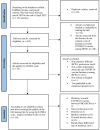Hesitancy Over the COVID-19 Vaccine Among Various Healthcare Workers: An International Narrative Review
- PMID: 38410316
- PMCID: PMC10896459
- DOI: 10.7759/cureus.53059
Hesitancy Over the COVID-19 Vaccine Among Various Healthcare Workers: An International Narrative Review
Abstract
Healthcare workers (HCWs) are role models in their communities. If they receive the COVID-19 vaccine, many people are likely to follow and have the vaccine. If HCWs are hesitant or resistant to taking the vaccine, this may impede the efforts to implement the vaccine, reach herd immunity, and eliminate the pandemic. In this narrative review, we reviewed previous studies on hesitancy over COVID-19 vaccination among different healthcare professions and people in the medical field, such as primary HCWs, dentists, nurses, and medical students. We reviewed the common reasons and associated factors for hesitancy toward the COVID-19 vaccine among different healthcare professions. The following keywords were used in the database search: COVID-19 AND vaccine AND hesitancy AND healthcare workers. We searched for articles using the PubMed, Scopus, and Google Scholar databases. We found HCW professions with various rates of hesitancy, including primary healthcare center (PHC) workers (50%), medical students (45%), nurses (21%), and dentists (18%). Hesitancy toward booster doses was also found in HCWs who had taken primary doses (2.8% to 26%). Race and ethnicity also influenced hesitancy rates, with Black individuals being the most hesitant group. The most common reasons were concerns about the safety and adverse effects of the vaccine, insufficient information, and a lack of confidence in healthcare policies. Despite varying rates of HCW hesitancy after the vaccine's release, this hesitancy is expected to negatively affect efforts to achieve widespread vaccination. The recommendations to policymakers to address these concerns are raising the awareness of PHC doctors because they are the easiest to reach and are the first line for patient information, improving communication with the HCWs through all channels (e.g., webinars, e-mails, and social media), and inviting HCWs to online meetings or workshops with the healthcare policymakers so the policymakers can listen to their concerns and recommendations. Correctly addressing the issue of HCWs' vaccination hesitancy can support efforts to contain the pandemic.
Keywords: covid-19; healthcare workers; hesitancy; resistant; vaccine.
Copyright © 2024, Aldakhlan et al.
Conflict of interest statement
The authors have declared that no competing interests exist.
Figures
Similar articles
-
Ethnic differences in SARS-CoV-2 vaccine hesitancy in United Kingdom healthcare workers: Results from the UK-REACH prospective nationwide cohort study.Lancet Reg Health Eur. 2021 Oct;9:100180. doi: 10.1016/j.lanepe.2021.100180. Epub 2021 Jul 19. Lancet Reg Health Eur. 2021. PMID: 34308406 Free PMC article.
-
Predictors of Vaccine Hesitancy among Health Care Workers during the COVID-19 Pandemic.Int J Environ Res Public Health. 2022 Jun 10;19(12):7123. doi: 10.3390/ijerph19127123. Int J Environ Res Public Health. 2022. PMID: 35742372 Free PMC article.
-
Understanding the barriers and facilitators of vaccine hesitancy towards the COVID-19 vaccine in healthcare workers and healthcare students worldwide: An Umbrella Review.PLoS One. 2023 Apr 12;18(4):e0280439. doi: 10.1371/journal.pone.0280439. eCollection 2023. PLoS One. 2023. PMID: 37043505 Free PMC article.
-
Hesitancy of Arab Healthcare Workers towards COVID-19 Vaccination: A Large-Scale Multinational Study.Vaccines (Basel). 2021 May 2;9(5):446. doi: 10.3390/vaccines9050446. Vaccines (Basel). 2021. PMID: 34063313 Free PMC article.
-
COVID-19 vaccination hesitancy in Italian healthcare workers: a systematic review and meta-analysis.Expert Rev Vaccines. 2022 Sep;21(9):1289-1300. doi: 10.1080/14760584.2022.2093723. Epub 2022 Jun 30. Expert Rev Vaccines. 2022. PMID: 35757890
Cited by
-
Vaccine Hesitancy and Associated Factors Amongst Health Professionals: A Scoping Review of the Published Literature.Vaccines (Basel). 2024 Dec 13;12(12):1411. doi: 10.3390/vaccines12121411. Vaccines (Basel). 2024. PMID: 39772072 Free PMC article.
-
Health Care Personnel Attitudes Toward Pediatric COVID-19 Vaccines.PRiMER. 2024 Oct 4;8:53. doi: 10.22454/PRiMER.2024.405060. eCollection 2024. PRiMER. 2024. PMID: 39569083 Free PMC article.
-
A Greek Nationwide Survey About Sources of Information on Seasonal Influenza and COVID-19 Vaccination Used by Healthcare Facility Staff During the Pandemic.Healthcare (Basel). 2025 Mar 19;13(6):670. doi: 10.3390/healthcare13060670. Healthcare (Basel). 2025. PMID: 40150520 Free PMC article.
-
Vaccination rate and symptoms of long COVID among dental teams in Germany.Sci Rep. 2025 Apr 21;15(1):13654. doi: 10.1038/s41598-025-96670-8. Sci Rep. 2025. PMID: 40254623 Free PMC article.
References
-
- Ten threats to global health in 2019. 2019. https://www.who.int/news-room/spotlight/ten-threats-to-global-health-in-... https://www.who.int/news-room/spotlight/ten-threats-to-global-health-in-...
Publication types
LinkOut - more resources
Full Text Sources

